Etude de bruit de fond induit par les muons dans l'expérience ...
Etude de bruit de fond induit par les muons dans l'expérience ...
Etude de bruit de fond induit par les muons dans l'expérience ...
Create successful ePaper yourself
Turn your PDF publications into a flip-book with our unique Google optimized e-Paper software.
tel-00724955, version 1 - 23 Aug 2012<br />
2.3 Direct <strong>de</strong>tection 37<br />
we must generally consi<strong>de</strong>r a three-<strong>par</strong>ameter space: ap, an, and Mχ. Furthermore,<br />
it means that the finite-momentum-transfer effects of the form factor cannot be<br />
factored out of the cross section in a mo<strong>de</strong>l-in<strong>de</strong>pen<strong>de</strong>nt fashion. The distributions<br />
of proton and neutron spin may be very different in a given nucleus, and so finite<br />
momentum effects may be very mo<strong>de</strong>l-<strong>de</strong>pen<strong>de</strong>nt. The preferred way to <strong>de</strong>al with<br />
this is to follow [106] by writing the WIMP-nucleus differential cross section in<br />
the form<br />
dσSD<br />
=<br />
dq2 where v is the inci<strong>de</strong>nt velocity and<br />
8G2 F<br />
S(q) (2.7)<br />
(2J + 1)v2 S(q) ≡ a 2 0S00(q) + a0a1S01(q) + a 2 1S11(q) (2.8)<br />
with a0 ≡ ap+an and a1 ≡ ap−an. S(q) encompasses the effects of finite momentum<br />
transfer, as well as values for the neutron and proton spin expectations ∗ . There is<br />
no universal form of S(q). It must be computed se<strong>par</strong>ately for each nucli<strong>de</strong> using<br />
nuclear structure mo<strong>de</strong>ls [104, 105].<br />
Although neutralinos often have intrinsically larger spin-<strong>de</strong>pen<strong>de</strong>nt than spin<br />
in<strong>de</strong>pen<strong>de</strong>nt couplings to nucleons, due to the great power of coherent enhancement<br />
– Equation 2.4 shows that scalar interactions are enhanced by the square of the<br />
target nuclear mass, while the spin-<strong>de</strong>pen<strong>de</strong>nt cross-section in Equation 2.7 does<br />
not increase with A –, spin in<strong>de</strong>pen<strong>de</strong>nt WIMP-nucleus cross sections are generally<br />
much greater. Because of this, and because of the relative rarity of heavy spinsensitive<br />
isotopes, spin-in<strong>de</strong>pen<strong>de</strong>nt interactions are targeted by most leading direct<br />
searches.<br />
2.3.4 Event rate<br />
The differential rate for scalar interactions can be written in terms of σ0 SI from<br />
Equation 2.3:<br />
dR<br />
dE = ρ0σ0 SI |F (q)|2<br />
2Mχµ 2<br />
<br />
f(v, t)<br />
d<br />
v<br />
3 v (2.9)<br />
v>q/2µ<br />
The lower limit of integration is the minimum WIMP velocity required in or<strong>de</strong>r<br />
to be kinematically possible for an energy E to be transferred to the nucleus. For<br />
the velocity profile, we assume a Maxwellian distribution truncated at the galactic<br />
escape velocity vesc. However, vesc is large enough, so that it has little effect on the<br />
calculation, and so we have omitted it here. The Maxwellian distribution is<br />
f(v)d 3 v = 1<br />
v 3 0π 3/2 e−v2 /v 2 0d 3 v (2.10)<br />
with a characteristic velocity v0 = 270 km/s in the solar neighborhood and truncated<br />
at a galactic escape velocity of vesc ≈ 650 km/s. Substituting this form into<br />
Equation 2.9 gives an energy spectrum that is a falling exponential modified by<br />
F (q). Then, the differential rate is<br />
dR<br />
dE = ρ0σ0 <br />
SI |F (E)|2<br />
√ exp −<br />
πv0Mχµ 2 EMN<br />
2µ 2v2 <br />
(2.11)<br />
0<br />
∗ There is a variation on this method advocated by some authors [58, 101] in which the scattering<br />
expressions are ma<strong>de</strong> to look more similar to those in the SI case by multiplying the above<br />
expression for σSD by a mo<strong>de</strong>l-<strong>de</strong>pen<strong>de</strong>nt form factor F 2 (q) = S(q)/S(0). This is equivalent in<br />
principle, but the division by S(0) may increase numerical errors in practice.<br />
2




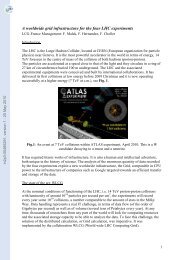

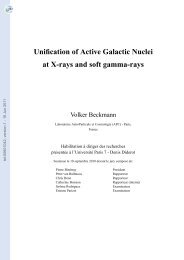

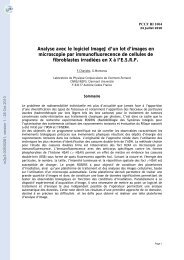
![[in2p3-00383985, v1] NUCLEAR PHYSICS at GANIL ... - HAL - IN2P3](https://img.yumpu.com/19016755/1/185x260/in2p3-00383985-v1-nuclear-physics-at-ganil-hal-in2p3.jpg?quality=85)
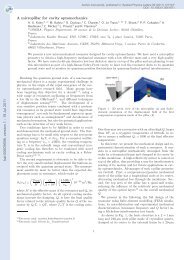
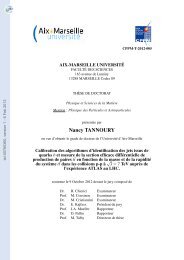
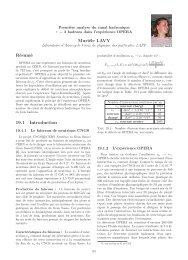
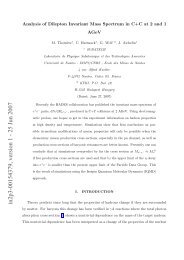
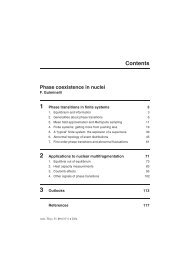
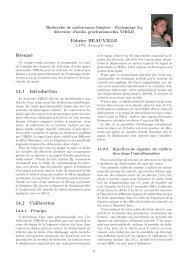
![[tel-00752304, v1] Pions réels et virtuels dans les noyaux](https://img.yumpu.com/19016523/1/184x260/tel-00752304-v1-pions-reels-et-virtuels-dans-les-noyaux.jpg?quality=85)